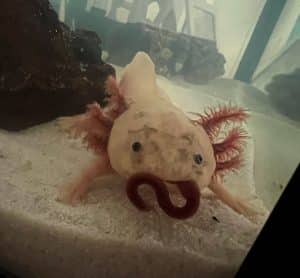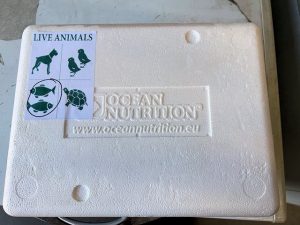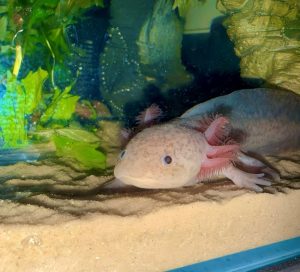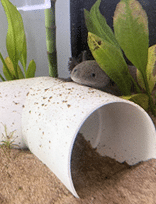Axolotls:
How do I tell the gender?
A: Telling the gender of an axolotl is not as easy as other species. Axolotls must reach sexual maturity before being able to determine their gender. This stage takes place around 8 -12 months, to tell the gender, you will need to look underneath the axolotl, behind their back legs and at the top of the tail is their cloaca’s. If you can see a definite rounded bulge then your axolotl is a male, it can be tricky to tell, as females can also have a slight bulge, this may also be more visible if the axolotl needs to remove waste, making a female possibly look a bit like a male, females also tend to have a more round body shape and are larger than males.
What can I feed my axolotl?
A: Here at Axolotls Australia, we feed our fish a variety of nutritious food. Our adults receive a mixture of minced kangaroo hearts and frozen bloodworms. We feed our juveniles that are around 8-15 cm bloodworms, and our babies that are around 2-8cm, we feed daphnia (water fleas). Older axolotls around 1-2 years can be fed every second day, and younger axolotls 1-2 times a day. You may also feed larger axolotls live earth worms, to feed live earth worms, you can drop the food in and let it float down, hand feed them or use a pair of long dull tweezers to feed them.

Delivery:
Do you ship to TAS and VIC?
A: Axolotls Australia are able to ship to VIC and all around Australia, however we are not allowed to ship to Tasmania, in fact it is illegal to import or keep an axolotl as a pet in Tasmania, this is due to axolotls not being a native animal to Australia, they are considered a high risk species of becoming a pest. Tasmania has strict regulations on the import and keeping of non-native animals to protect its unique environment and agriculture. We do ship to WA, however we must let you know before shipping to WA, live animals are subject to random inspection which can involve and inspection fee, around the amount of $69.
How long does delivery take?
A: We ship our axolotls’ with team global, they are sent out every Tuesday to ensure they arrive on time, and avoid being held in the post office over the weekend, as the oxygen we use may not last that long, depending on if you are metro or out of range, delivery should take 1-2 working days, once your order has been collected by team global, we will send you a tracking number.
Tank:
How big should my tank be?
A: For a juvenile axolotl a recommended tank size is 45cm wide x 30 cm deep x30cm high, this works out to be around 40 liters, this should comfortably house 1 juvenile axolotl with room to grow, for 2 axolotls or adults we recommended a 60-liter tank.
Is gravel ok for my tank?
A: No, as much as it may seem ok, Gravel is dangerous to use as a substrate for your axolotls, this is due to the size of the gravel looking like food. Your axolotl may try to eat it and potentially choke, real food may also fall between the gaps of the gravel, causing the tank to be harder to clean and becoming dirtier faster, protentional ruining the water levels. For axolotls we recommend sand as a safe substrate or no substrate at all.
How long do I let the water sit?
A: If your tank is all set up, you will need to let the water sit for a week before introducing your axolotl, to ensure any harmful chemicals have time to go away and the environment is safe. Once your tank is ready and your axolotl arrives, we recommend floating your axolotl in the tank, inside the bag for about 45 minutes before releasing them into their new home.
How do I set up the tank?
A: Setting up the tank and having it ready before you order your axolotl is very important, if you are unsure how to set up the tank, we have a section on our website under 'About' on how to set up a tank, or please feel free to email us and we can send you the PDF on how to do so.
Illness:
Why does my axolotl have white spots?
A: If your axolotl has white fluffy spotting on its gills and body, this may be a sign of fungus, to help you should make sure your axolotl receives the right treatment. You should be able to purchase some treatment from your local pet store. Once you notice the spots, it is important to do a water change as the fungus can be a result as poor water conditions.
Why isn’t my axolotl eating?
A: Axolotls are very temperamental animals, they can be stressed very easily, if you have just received your axolotl they may take some time to settle in before they feel comfortable enough to eat, however if you have had your axolotl for a while and they stop eating, we recommend checking the water conditions, and possibly changing their diet. They may be uninterested in the food, you can also try hand feeding them if you don’t already. Axolotls can have a range of food in their diet such as frozen bloodworms, live earth worms and axolotls pellets.


